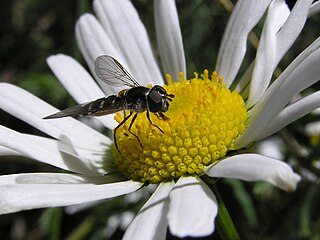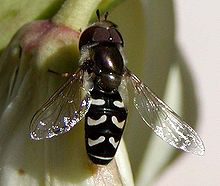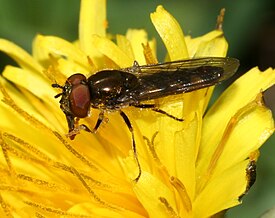
Syrphus ribesii is a very common Holarctic species of hoverfly. Its larvae feed on aphids. In common with many other species of hoverfly, males have the eyes meeting on the top of the head, whilst females have their eyes widely separated.

Syritta pipiens, sometimes called the thick-legged hoverfly, is one of the most common species in the insect family Syrphidae. This fly originates from Europe and is currently distributed across Eurasia and North America. They are fast and nimble fliers, and their larvae are found in wet, rotting organic matter such as garden compost, manure, and silage. The species is also commonly found in human-created environments such as most farmland, gardens, and urban parks, wherever there are flowers. This species is an important part of its native ecosystem as adult Syritta pipiens flies are critical pollinators for a variety of flowering plants and the species supports parasitism by various parasitic wasp species. Thus, they play an important role in environmental functionality, and can serve as bio-indicators, in which their abundance can reflect the health of the environment. Syritta pipiens looks like many predatory hoverfly species, yet is not predatory.

Leucozona lucorum is a Palearctic and Nearctic species of hoverfly.

Meliscaeva cinctella is a Holarctic species of hoverfly.

Pipizini is a tribe of small to medium-sized generally black hoverflies, although some species also have orange spots on their abdomen. This nondescript colouring can lead to some species being confused with other dark hoverflies from other tribes. The lack of a facial knob is a good defining feature which separates them from most of these other hoverflies. As with other species in the subfamily Syrphinae the larvae feed on aphids though there seems to be a preference for wax-secreting aphids e.g. Pemphigidae.

Syrphus torvus, the Hairy-eyed Flower Fly, is a common species of hoverfly found in the Holarctic. The adults feed on pollen and nectar, but the larvae feed on aphids.

Syrphus vitripennis is a very common European and North American species of hoverfly. Its larvae feed on aphids

Epistrophe grossulariae is a Holarctic species of hoverfly.

Melangyna umbellatarum is a Holarctic species of hoverfly.

Melangyna compositarum is a Holarctic species of hoverfly.

Meligramma guttatum is a Holarctic species of hoverfly.

Megasyrphus erraticus is a Holarctic species of hoverfly associated with mature conifer woodlands and plantations.

Didea alneti is a Holarctic species of hoverfly.

Melangyna novaezelandiae is a hoverfly endemic to New Zealand. It is a generalized pollinator of a large range of plants that are both native and exotic to the New Zealand flora. M. novaezelandiae is widespread throughout New Zealand, including in agricultural environments. The larvae of this species feeds on other arthropods and may have uses as a biocontrol agent.

Epistrophe nitidicollis is a European and North American species of hoverfly.

Syrphus knabi, the Eastern flower Fly, is an uncommon species of syrphid fly observed in the eastern United States and Canada. Syrphid flies are also known as Hover Flies or Flower Flies because the adults are frequently found hovering around flowers from which they feed on nectar and pollen. Adults are 7.2–12.9 mm (0.28–0.51 in) long. The larvae are predators of a variety of aphids in trees.
Syrphus rectus, the yellow-legged flower fly, is a species of fly in the family Syrphidae, the hover flies. Syrphus rectus is a common fly in the eastern United States and southeastern Canada and has occasionally been seen in Europe. Like many hoverflies, it has strongly contrasting black and yellow bands on the abdomen.
Sphaerophoria asymmetrica , the asymmetric globetail , is a common species of syrphid fly observed across northern North America. Hoverflies can remain nearly motionless in flight. The adults are also known as flower flies for they are commonly found on flowers from which they get both energy-giving nectar and protein rich pollen. The larvae feed on aphids.

Eupeodes pomus, the short-tailed aphideater, is a species of syrphid fly observed across North America. Hoverflies can remain nearly motionless in flight. The adults are also known as flower flies for they are commonly found on flowers from which they get both energy-giving nectar and protein-rich pollen. Larvae have been reported feeding from various aphids.

Sphaerophoria bifurcata, the symmetric globetail, is a species of syrphid fly in the family Syrphidae. The larvae of this genus are predators of aphids and other small hymenoptera. The larvae of this particular species is not known.


























